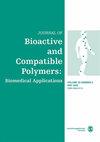Construction of injectable collagen-microgel/tannic acid/nano-hydroxyapatite granular hydrogel and evaluation of its potential in wound healing
IF 2.1
4区 生物学
Q3 BIOTECHNOLOGY & APPLIED MICROBIOLOGY
引用次数: 0
Abstract
Granular hydrogel is a kind of hydrogel assembled from micro-particles, possessing micro-porous structure that advanced in terms of exudate absorption, mass exchange and cell migration during wound healing. The present study fabricated an injectable granular hydrogel based on tannic acid (TA) connected collagen (COL)-microparticles and hydroxyapatite nanoparticles (nHA). Through the coordination of calcium and phenolic hydroxyl groups, TA was bound on nHA surface to form TA modified nano-hydroxyapatite, TA@nHA. The content of TA bound on nHA surface was as high as 30%. TA@nHA as high as 20% was used as giant crosslinking component to connect COL microgels (COLmg) via hydrogen bond, forming COLmg@TA@nHA granular hydrogel. The size of COL microgels could be controlled via adjusting stirring speed. The larger COL microgels assembled granular hydrogel possessed higher porosity. While the smaller COL microgels assembled granular hydrogel was more stable, showing better self-healing ability in rheological test. Due to the dynamically reversible interactions, COLmg@TA@nHA granular hydrogel was injectable, which could be applied to the skin wound, exhibiting the ability to inhibit inflammatory response, while enhance α-SMA expression, promoting wound healing. The method to fabricate granular hydrogel introduced in this study has a broad scalability toward repairing various tissues.可注射胶原微凝胶/单宁酸/纳米羟基磷灰石颗粒水凝胶的构建及其伤口愈合潜力评价
颗粒水凝胶是一种由微颗粒组装而成的水凝胶,具有微孔结构,在伤口愈合过程中具有较强的渗出液吸收、质量交换和细胞迁移能力。本研究制备了一种以单宁酸(TA)连接胶原蛋白(COL)微粒和羟基磷灰石纳米颗粒(nHA)为基础的可注射颗粒水凝胶。通过钙和酚羟基的配位,TA结合在nHA表面形成TA修饰的纳米羟基磷灰石TA@nHA。结合在nHA表面的TA含量高达30%。以高达20%的TA@nHA作为巨交联组分,通过氢键连接COL微凝胶(COLmg),形成COLmg@TA@nHA颗粒水凝胶。通过调节搅拌速度可以控制COL微凝胶的大小。较大的COL微凝胶组合的颗粒水凝胶具有较高的孔隙率。而较小的COL微凝胶组装的颗粒状水凝胶更稳定,在流变试验中表现出更好的自愈能力。由于动态可逆的相互作用,COLmg@TA@nHA颗粒水凝胶可注射,可应用于皮肤创面,表现出抑制炎症反应的能力,同时提高α-SMA的表达,促进创面愈合。本研究所介绍的颗粒水凝胶制备方法在修复各种组织方面具有广阔的可扩展性。
本文章由计算机程序翻译,如有差异,请以英文原文为准。
求助全文
约1分钟内获得全文
求助全文
来源期刊

Journal of Bioactive and Compatible Polymers
工程技术-材料科学:生物材料
CiteScore
3.50
自引率
0.00%
发文量
27
审稿时长
2 months
期刊介绍:
The use and importance of biomedical polymers, especially in pharmacology, is growing rapidly. The Journal of Bioactive and Compatible Polymers is a fully peer-reviewed scholarly journal that provides biomedical polymer scientists and researchers with new information on important advances in this field. Examples of specific areas of interest to the journal include: polymeric drugs and drug design; polymeric functionalization and structures related to biological activity or compatibility; natural polymer modification to achieve specific biological activity or compatibility; enzyme modelling by polymers; membranes for biological use; liposome stabilization and cell modeling. This journal is a member of the Committee on Publication Ethics (COPE).
 求助内容:
求助内容: 应助结果提醒方式:
应助结果提醒方式:


